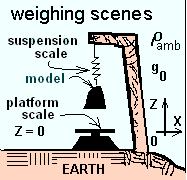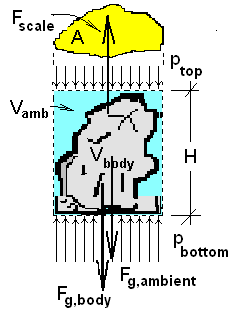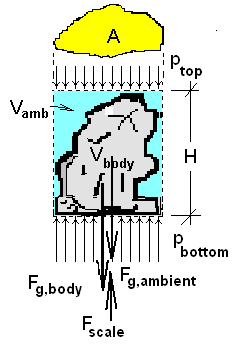| THERMO Spoken Here! ~ J. Pohl © | TOC NEXT ~ 91 |
Volume of a Sculpture
Many replicas of a sculpture with very many intricate cavities are to be made. The completed model is given to a technician to determine the volume of precious metal each replica will require. The material of the sculpture is compact and its density is known. Although the model cannot be immersed in water, two precision scales are available. One device is a suspension scale the other is a platform scale. A sketch showing the two scales and model is shown.

Calculate the volume of the model by either weighing method.
♦ By Suspension Scale: As our system, we envisage a vertical, generated cylinder that bounds the model along with some air inside of it and beside it. The horizontal top of the system, where our cylinder contacts the top of the model, has the constant pressure of the atmosphere, patm,top. Across the flat bottom of the model, the atmospheric pressure is patm,bottom. The sketch below right shows our system, extracted from its physical reality - represented as a "free-body-diagram."
Newton's Second Law is applied to the system as follows:

 |
(1) 1 |
We scalar multiplied by K to get the vertical parts. Of gravity forces, there are two. The surface forces are that of the scale and the pressure-forces , top and bottom.
 |
(2) 2 |
We will substitute to represent the masses as densities times volumes. Also there is a relation between the atmospheric pressures, top and bottom.
 |
(3) 3 |
Next we make substitutions and apply careful algebra. Check these steps!
 |
(4) 4 |
The above equation, condenses considerably with further algebra.
 |
(5) 5 |
This reduction, known 200 or so years ago, lead to a famous interpretation. When the first two terms are grouped together, a new idea, a new force appears - the buoyant force. To others buoyancy is a pseudo-force, a conclusion by algebraic combination of pure body and surface forces. That aside, our solution of the volume is at hand. All quantities superscripted asterisk (*) are known. providing a solution for the desired quantity superscripted (?).
 |
(6) 6 |

♦ By the Platform Scale: Of course we must obtain the same answer as above. This approach, however, poses an interesting question. Our system is the model. We represent the force of the scale (awkwardly drawn in the sketch) as a single force vector. Starting with the "weighing scenes" image above, imagine the changes as the suspending cord pays out, lowering the model to rest completely, in full contact flatly, upon the face of the depressed platform scale. As the model (as system) contacts, abuts the flat face of the scale does the pressure-force (patm,bottomAface) vanish as forces "equal and opposite" do upon contact.
The answer is no. The pressure-force would vanish only if we included the supporting plate as system. An if we include the plate, we must account for its gravitational force and we must draw a new, lower boundary. Logically that boundary would be the bottom of the plate which contacts air. If System A contacts System B and you want a new perspective (A + B) then draw a new picture. The atmospheric pressure-force distribution is retained.
Volume of a Sculpture
Many replicas of a sculpture are to be made. The completed model is given to a technician to determine the volume of precious metal each replica will require. The material of the model is compact and its density is known. Although the model cannot be immersed in water, two precision scales are available.
Premise presently unwritted!